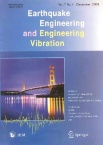学术论文详情
Experimental research and finite element analysis of bridge piers failed in flexure-shear modes
摘要:In recent earthquakes,a large number of reinforced concrete (RC) bridges were severely damaged due to mixed flexure-shear failure modes of the bridge piers.An integrated experimental and finite element (FE) analysis study is described in this paper to study the seismic performance of the bridge piers that failed in flexure-shear modes.In the first part,a nonlinear cyclic loading test on six RC bridge piers with circular cross sections is carried out experimentally.The damage states,ductility and energy dissipation parameters,stiffness degradation and shear strength of the piers are studied and compared with each other.The experimental results suggest that all the piers exhibit stable flexural response at displacement ductilities up to four before exhibiting brittle shear failure.The ultimate performance of the piers is dominated by shear capacity due to significant shear cracking,and in some cases,rupturing of spiral bars.In the second part,modeling approaches describing the hysteretic behavior of the piers are investigated by using ANSYS software.A set of models with different parameters is selected and evaluated through comparison with experimental results.The influences of the shear retention coefficients between concrete cracks,the Bauschinger effect in longitudinal reinforcement,the bond-slip relationship between the longitudinal reinforcement and the concrete and the concrete failure surface on the simulated hysteretic curves are discussed.Then,a modified analysis model is presented and its accuracy is verified by comparing the simulated results with experimental ones.This research uses models available in commercial FE codes and is intended for researchers and engineers interested in using ANSYS software to predict the hysteretic behavior of reinforced concrete structures.
©2025 王东升-桥梁抗震与减震控制研究团队 京ICP备18023726号-1
技术支持: Geecho
